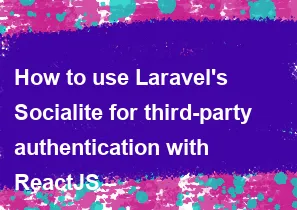How to use Laravel's Socialite for third-party authentication with ReactJS

Laravel's Socialite is a powerful package for handling third-party authentication in Laravel applications. To use Socialite with ReactJS for third-party authentication, you can follow these general steps:
Set Up Laravel with Socialite:
Start by setting up Socialite in your Laravel application. Install the Socialite package using Composer:
bashcomposer require laravel/socialiteAdd your social media credentials in the
config/services.phpfile. For example, if you're integrating with GitHub, add your GitHub app credentials:php'github' => [ 'client_id' => env('GITHUB_CLIENT_ID'), 'client_secret' => env('GITHUB_CLIENT_SECRET'), 'redirect' => env('GITHUB_REDIRECT_URI'), ],Set up the necessary routes and controller methods for handling the authentication flow.
Create API Endpoints:
Create API endpoints in your Laravel application that will be used to initiate and complete the authentication process. These endpoints will be responsible for redirecting the user to the social media provider's login page and handling the callback after authentication.
ReactJS Frontend:
In your ReactJS application, create components and UI elements for the login page. When the user clicks on the login button for a specific social media provider, make a request to your Laravel API endpoint that initiates the Socialite authentication flow.
Use an HTTP library like Axios or the native
fetchAPI to make the requests. For example:jsximport React from 'react'; import axios from 'axios'; const Login = () => { const handleSocialLogin = (provider) => { // Make a request to your Laravel API endpoint to initiate Socialite authentication axios.get(`/api/auth/${provider}`) .then((response) => { // Redirect the user to the social media provider's login page window.location.href = response.data.redirect; }) .catch((error) => { console.error(error); }); }; return ( <div> <button onClick={() => handleSocialLogin('github')}>Login with GitHub</button> {/* Add buttons for other social media providers */} </div> ); }; export default Login;Handle Callback in Laravel:
After the user authenticates with the social media provider, they will be redirected back to your Laravel application. Implement the callback endpoint in Laravel to handle the response from the provider, retrieve user information, and create or log in the user in your application.
Update ReactJS UI:
Once the authentication is successful, update your ReactJS UI to reflect the user's authenticated state.
Remember to secure your API endpoints and handle errors gracefully in both Laravel and ReactJS to provide a smooth user experience. Additionally, consider using Laravel Passport or another authentication mechanism to secure your API endpoints and manage user sessions.
-
Popular Post
- How to optimize for Google's About This Result feature for local businesses
- How to implement multi-language support in an Express.js application
- How to handle and optimize for changes in mobile search behavior
- How to handle CORS in a Node.js application
- How to use Vue.js with a UI framework (e.g., Vuetify, Element UI)
- How to configure Laravel Telescope for monitoring and profiling API requests
- How to create a command-line tool using the Commander.js library in Node.js
- How to implement code splitting in a React.js application
- How to use the AWS SDK for Node.js to interact with various AWS services
- How to use the Node.js Stream API for efficient data processing
- How to implement a cookie parser middleware in Node.js
- How to implement WebSockets for real-time communication in React
-
Latest Post
- How to implement a dynamic form with dynamic field styling based on user input in Next.js
- How to create a custom hook for handling user interactions with the browser's device motion in Next.js
- How to create a custom hook for handling user interactions with the browser's battery status in Next.js
- How to implement a dynamic form with dynamic field visibility based on user input in Next.js
- How to implement a dynamic form with real-time collaboration features in Next.js
- How to create a custom hook for handling user interactions with the browser's media devices in Next.js
- How to use the useSWRInfinite hook for paginating data with a custom loading indicator in Next.js
- How to create a custom hook for handling user interactions with the browser's network status in Next.js
- How to create a custom hook for handling user interactions with the browser's location in Next.js
- How to implement a dynamic form with multi-language support in Next.js
- How to create a custom hook for handling user interactions with the browser's ambient light sensor in Next.js
- How to use the useHover hook for creating interactive image zoom effects in Next.js